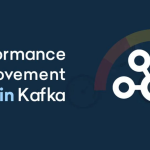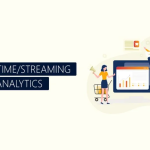In modern enterprises, data is the lifeblood that fuels decision-making. It flows in, gets analyzed, manipulated, and then transformed into new output. Every application generates data, whether it is conversational messages, metrics, user activity, outgoing messages, or anything else. This data has a story to tell and can offer insightful information.
But to interpret all of this information first, we must transfer the data from the point of origin to the analysis location. For example, when we browse on Amazon, our clicks on different items are used to create personalized recommendations for us.
Our ability to transport and analyze data quickly significantly impacts how adaptable and quick our businesses can be. We cannot concentrate on the most important core business tasks if we spend too much time and effort transporting data.
Because of this, a data-driven enterprise’s pipeline—the method for transporting data from one location to another—is so important.
The Significance of Real-Time Data Processing
Real-time streaming is very important for many data-driven business applications. Businesses are better equipped to react and make decisions rapidly thanks to their ability to instantly move and analyze data. Real-time streaming minimizes the time and effort needed for data transportation by enabling rapid data transfer from the point of origin to the analysis site. This is important because firms may concentrate on their primary duties rather than wasting too much time on data transportation.
Real-time data processing using pub/sub messaging is crucial for e-commerce platforms. Pub/sub messaging is a technique used to send and receive data between different applications or systems. It entails using a message network to convey data from one system—known as the publisher—to another system—known as the subscriber.
In pub/sub messaging, data is sent as messages, which contain information about the data being transmitted. The publisher sends messages to a messaging platform, which then delivers them to the subscriber. In the end, various systems talk to one another without actually connecting.
One common use case of pub/sub messaging is in e-commerce websites, where real-time data processing is critical. Consider a situation when you add a product to your cart during online shopping. At that moment, the website should immediately update the inventory so that other customers know if the product is still available. It should also update the order management system so that the website knows how many of those products are left in stock and can keep track of your order. All of this occurs in real time, ensuring a trouble-free shopping experience for you.
By using pub/sub messaging, the website can publish a message containing information about the product that was added to the cart, and the messaging platform can deliver that message to the inventory and order management systems. This enables these systems to update their data in real-time, ensuring that the inventory is accurate and the order is processed correctly.
Apache Kafka in Action
Real-time Stream Processing:
Kafka might be your go-to platform if you need to process and analyze enormous volumes of data in real-time swiftly. It is a well-liked option for streaming data processing since it is scalable, dependable, and fault-tolerant. Consider Uber as an example, they transmit real-time data from their app using Kafka and utilize it to analyze ride requests, GPS positions, and driver availability.
Kafka enables real-time data processing so you can react to changes and take decisions more quickly.
Data Integration:
Kafka can be used as a platform for real-time data integration to transport data between various systems. It’s an excellent method for gathering data from numerous sources and transferring it to various downstream systems for processing. For instance, LinkedIn updates user-profiles and offers tailored suggestions based on user interactions with their website using Kafka to transfer data between systems.
Hence, we can infer that Kafka is scalable and has fault-tolerant architecture, resulting in an excellent platform for real-time data integration. Additionally, it is adaptable and supports modular data architecture.
Microservices:
A messaging platform that supports numerous communication patterns and can handle large data volumes is required for microservices architecture. Kafka is a good choice! It’s an excellent messaging platform for microservice architectures, allowing them to interact and manage massive volumes of data. Kafka is the messaging system that Netflix utilizes to communicate between its various microservices.
Kafka’s scalable and fault-tolerant design supports a variety of communication patterns and grants microservices the option to engage in modular communication with one another.
Event Sourcing:
Kafka can be used as a platform for event sourcing, which is the process of inferring an application’s state from a series of events. For this purpose, Airbnb employs Kafka to store all the events that take place within its ecosystem, including visitor reservations, host reviews, and payment transactions. They then calculate the application’s current state using these events.
Kafka’s scalable and fault-tolerant platform gives developers the resilience they need to create systems with swift failure recovery.
IoT and Sensor Data:
IoT and sensor data processing and analysis are also very well suited for Kafka. Tesla streams information from its fleet of electric vehicles, such as battery charge levels, speed, and location information, to its data centers using Kafka. Kafka is a wonderful option for processing large volumes of data from IoT and sensor devices since it offers a scalable and fault-tolerant streaming platform.
How Kafka Facilitates Real-Time Streaming?
Have you ever encountered the problem of efficiently passing messages between different systems or applications? Well, Apache Kafka is a messaging system designed to solve that problem! It’s often called a “distributed commit log” or a “distributing streaming platform.” You can think of it like a filesystem or database commit log, which keeps a record of all transactions so that they can be replayed to build the state of a system consistently. In Kafka, data is also stored durably, in order, and can be read deterministically. The best part is that the data can be distributed within the system, which provides extra protection against failures and great opportunities for scaling performance.
Suppose, you work for an OTT platform company that provides a streaming service for watching movies and TV shows online. So as to give your consumers a seamless experience, you need a system that can manage big data, including streaming requests, user data, billing information, and more. Another of your main aims is to process this data rapidly and reliably.
Herein lies the role of Apache Kafka. Kafka can assist you in gathering all of this data as soon as it is generated and dispersing it throughout various components of your system so that it can be processed instantly.
For example, data engineers might use Kafka to collect user requests for streaming content and then distribute those requests to different servers for processing. Kafka’s publish/subscribe messaging system allows them to distribute these requests in a scalable and fault-tolerant way.
Using Kafka also has the advantage of allowing you to use its retention capability to save all of the real-time data generated for a set amount of time. This helps study data patterns and trends over a certain time.
For instance, you may be interested in figuring out the most sought-after movies among your users and how their popularity varies over time. By storing this data in Kafka, you can always go back and analyze it even after your system has processed it.
Divide and Conquer: Architecture of Kafka
By splitting the data into topics and divisions that may be dispersed across several servers, Kafka is fundamentally built to manage massive amounts of data. Producers write messages to Kafka topics, while consumers read messages from these topics. Kafka uses a publish-subscribe model, meaning that messages are published to a topic and any number of consumers can subscribe to that topic to receive those messages.
The Kafka cluster consists of several brokers, which are responsible for storing and serving data to producers and consumers. Each broker can handle multiple partitions and can act as a leader or follower for a given partition. The leader is responsible for handling all read and write requests for a partition, while the followers replicate the data from the leader and can take over if the leader fails.

Kafka also provides features such as replication and fault tolerance, which ensure that data is not lost even in the event of a broker failure. Replication ensures that each partition is replicated across multiple brokers, while fault tolerance allows Kafka to continue functioning even if a broker fails.
To handle big volumes of data, Kafka uses batching to write messages in chunks rather than individually. This reduces the overhead of sending and receiving individual messages and improves throughput. Moreover, Kafka supports data compression and preservation, enabling the storage and retrieval of massive amounts of data quickly.
Is Your Enterprise Ready to Adopt Apache Kafka?
No matter where your company is in its growth journey, Apache Kafka is an extraordinarily adaptable technology that can help it. Kafka can handle all situations, whether you\’re just getting started and experimenting with streaming data processing or whether you\’re a seasoned company in need of a central nervous system for your data architecture.
The platform is a top choice for processing streaming data because of its scalable and fault-tolerant architecture, and the greatest part is that it can simply expand your business.
Apart from data streaming, Apache Kafka offers incredible data security. However, to uncover its capabilities, a strong data security strategy must be put into place by C-suite executives and incorporate features like encryption, access restrictions, identity and access management, network security, and more.
Additionally, when creating their data management policies, organizations must take data privacy rules like GDPR and CCPA into account.
Finally, it’s crucial to create a culture of data privacy and security throughout your entire business by offering all staff training and awareness programs.








